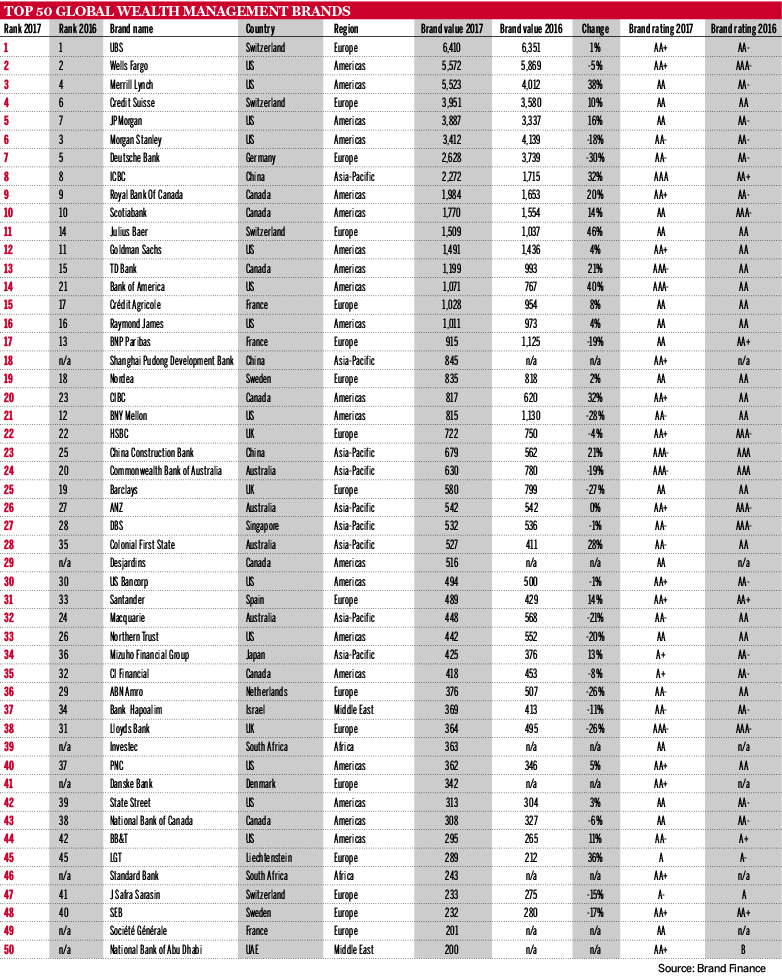Improved economic conditions and the strong performance of certain investment products have lifted prospects for private banks around the world. This is mirrored in their brand values, which have more than doubled on an aggregate level for the 50 biggest names over the past year, according to consultancy Brand Finance, which ranks banks running wealth and asset management operations.
The ranking is once again topped by UBS with a $6.41bn brand value. While most other names are also internationally renowned players, the list shows uneven performances within and across geographical markets.
Among the leading US names, for example, while Merrill Lynch, JPMorgan and Bank of America grew their brand values by 38%, 16% and 40%, respectively, Wells Fargo and Morgan Stanley moved in the opposite direction, with respective declines of 5% and 18%. The climbers were helped by improved macroeconomic conditions in the US, where private wealth expanded by 4.5% to reach $55,700bn – the world’s largest private wealth market – as noted by Boston Consulting Group (BCG) in its Global Wealth 2017 report, which looked at the previous year’s data.
According to the report, improved equity portfolios were also a factor behind the wealth market growth. This failed to help Wells Fargo, however, still dealing with the reputational damage caused by problems at its retail bank. For its part, Morgan Stanley recorded margin considerably lower than its peers, according to Brand Finance.
China's expansion
Asia, which saw the biggest wealth market expansion (9.5% to $38,400bn) produced four of only eight emerging market names in the ranking. China is the best performer of the group, with ICBC in eighth place. The lender’s brand is now valued at $2.27bn, a 32% improvement on the previous ranking. Better data available for Shanghai Pudong Development Bank has allowed a more granular analysis of its operations and elevated it to 18th place, while China Construction Bank has climbed two places to 23rd thanks to a 21% brand value growth. Local players are the most obvious beneficiaries of new wealth creation in China and the rest of emerging Asia, but well placed international firms are also set to reap rewards.
David Haigh, CEO of Brand Finance, notes China’s growing brand awareness across products and services, which will likely apply to wealth management and benefit all foreign providers, even when those that do not enjoy a widely-recognised brand.
“One of the things about China is that they’re becoming increasingly sophisticated in their understanding of brands in all categories and particularly at the top end,” says Mr Haigh. “For example, they buy foreign cars because they’re a status symbol; when it comes to education they’re very aware of universities such as Oxford, Cambridge and Harvard; and when it comes to luxury goods, they’ve moved on from the flashy names like Chanel to very discrete brands like Asprey. It wouldn’t surprise me if the same sort of trend were to happen in wealth management.”
China has certainly been an important market for UBS, where the bank has been operating for 50 years and where it recently launched a digital branding campaign targeting specific Chinese cities.
“In Asia, the prime competition is from the local players [but] typically the services that we offer and the services that the local players offer are complementary because often they’re not able to offer that depth and breath [that we can provide] beyond their borders,” says Hubertus Kuelps, UBS’s group head of communications and branding. Without breaking down figures, he adds that first-quarter data for 2017, the most recently available, was particularly strong for UBS in the Asia-Pacific region.
Swiss polished
Swiss names continue to dominate the European market and outpace the growth of other key regional brands. After UBS, Credit Suisse is the largest European brand in the ranking, in fourth place, while Julius Baer is closing the gap with Deutsche Bank. The German bank slipped to seventh place globally with a brand value 30% smaller than in 2016, while Julius Baer climbed to 11th thanks to 46% brand value growth, the largest in the ranking.
A need to streamline the costs of running international operations may shake up the Swiss market, according to Anna Zakrzewski, partner at BCG, who notes that the local market went from hosting 312 banks and 108,000 employees in 2011 to 260 banks and 102,000 staff this year. Further consolidation and rationalisation of international operations might further strengthen UBS and its successful Swiss peers.








